Notes from Miss Alena
“Do you use computers in your school?” This is a question we have received from some parents. While we do at times utilize computers to give our students additional information through videos, our main focus is to provide children with library skills.
In the Lower Elementary years especially, we stress library skills and include a basic instruction to technology as it relates to classroom work. It is most important that children are able to learn how to use non- fiction books, encyclopedias, dictionaries and atlases throughout the Pre-school, Kindergarten, and first year of Lower Elementary. In the following years of Elementary, students are exposed to more computer skills to utilize in research project if necessary.
Warmly,
Miss Alena
Working with Montessori materials:
Introducing Seasons in the Montessori Classroom

In the Montessori classroom, we begin the study of history or the “passage of time” at the very beginning of the school year. One of the ways that we promote this understanding is to learn about the cycle of the year. In Northern Illinois, we experience four distinct seasons (fall, winter, spring, and summer). The children are able to understand the basic characteristics of each season in a very experiential way.
I have noticed over the years how much the children enjoy watching the seasons change. As we experience this passing of time, the materials in the classroom are changed out to reflect that particular season. For example, during autumn, we would study about apples, pumpkins, and the changing colors of the leaves. We would also learn about animals and how they prepare for each season. In the winter, we may learn about snow (ice crystals), animal hibernation, and present science experiments that involve the cold weather. During spring, we go outside to observe the buds on the trees or the flower bulbs that are beginning to merge. Of course this sparks their interest in seeds and we do many planting activities in the classroom.

There are simple activities on our shelves that help reinforce the learning of the seasons and help give children a simple understanding of the passage of time:
• Sorting of photos that represent the 4 seasons (fall, winter, spring, summer)
• The sequencing of the apple tree
* Spring: “The tree is full of flowers…
* Summer “The tree is full of green leaves…
* Fall “The tree is full of apples…
* Winter “The tree is bare and empty…
• Books that represent each season
• Birthday timeline or celebration of the child.
The direct aim is to create a deeper impression of the names, sequence, clothing, holidays, and typical activities associated with each season.
Ms Patty
Working with Montessori materials:
The Passage of Time

In a Montessori 3-6 classroom, the history area is an assortment of works for the children to explore the idea of the passage of time. Some of these works include building a monthly calendar, sorting pictures by the seasons, time lines and clock work. The foundational activities that children work on however are learning the days of the week and the months of the year.
The days of the week are usually first learned through a song during group time. We have several songs we sing and the learning of the order and vocabulary is easily grasped when put to a tune and chanted together. Individual works such as matching word cards and ordering vocabulary labels provide additional practice. Later the concepts of yesterday, today and tomorrow are introduced. Kindergarten children are utilizing their knowledge of the days of the week to record finished works in their work plans.
The Months of the year are introduced in the classroom as it relates to everyday life in order to make it meaningful for the children. For example, in the South Room every month a different child brings in library books for our author of the month. When these books arrive, at line time we incorporate this information to our introduction of our new author. “Yesterday was the last day of February, today is the first day of March. Sydney brought in books for our March Author of the Month, Bill Martin Jr.”. Then as we read books on different days we ask questions to prompt the knowledge of the month “Our author of the Month is Bill Martin Jr., who remembers what month it is”.
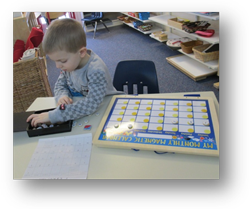
Also in the classroom, there is often a morning message written on our white board stating the date and any important information for the children that day: “Today is Wednesday, March 20, 2013. Today is the first day of spring”. Children who are readers enjoy reading the morning message to themselves and the other children in the class. Matching cards, memory game sets and 1-12 ordering of the months are other works available to children as they show interest and readiness.
At home you can easily incorporate practicing the days of the week and months of the year by having a monthly calendar displayed at eye level for your child. With your child write in special holidays and birthdays or days your child attends school or what is to be served for lunch each day. Then before bed your child could be responsible for checking what is coming up the next day and then together you could mark off the current day with a child-drawn happy face.
Miss Jocelyn
“The Five Great Lessons” in Montessori Elementary Curriculum

“The Five Great Lessons” is a group of impressionistic stories that are meant to provide elementary Montessori students with a ‘big picture’ of the world and life. At this stage of development, children are becoming aware of the world and their place in it. For a child, the Great Lessons are more than just educational and inspirational stories. They spark the imagination and lead students to contemplate not only the past, but the future. It is through the telling (and re-telling) of these important Cosmic Lessons that students are motivated to further research and works in the Montessori classroom.”
(http://montessoritraining.blogspot.com)
The above is an excellent and concise explanation of the why we tell the Great Lessons during the Elementary years in Montessori. This month I wanted to focus on one of the Great Lessons and give a bit of a glimpse as to the content of the lesson. I chose to focus on the story of Communication in Signs also called the “The Story of Writing.”
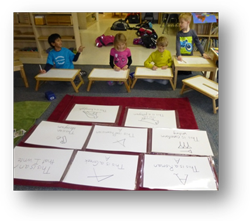
Before the story starts children are led to think about what was the first word human beings ever spoke? This idea is to really get the imagination going. It then leads into the story of written communication. The story tells the progression of written language starting with pictographs and ending with how we currently write. The attention of the children is drawn to the fact that as written language increased, human communication could increase as well. People could now keep records of history and write stories. As with any Great Lesson, the children are left with a sense of amazement and wonder.
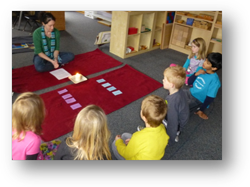
All Great Lessons lead into wonderful follow up work. A few extensions of the Story of Writing include: writing letters to friends, making a secret code, writing on papyrus paper using ink, cuneiform writing in clay, hieroglyphics, paper making, study of other alphabets, and mastering good penmanship. The Story of Writing is also, of course, connected to the Language curriculum of the classroom. It helps to give a child meaning to the work they are doing when reading a book, writing creativity, learning Spanish or symbolizing nouns and articles in sentences.
If you ever have any questions about the Great Lessons please feel free to ask via email, a phone call or just stop in. The stories are told each year during the Elementary three year cycle and every time the child walks away with a new sense of wonder and curiosity to fuel their learning.
Miss Katy
Notes from the Elementary Class (North room):
Ms. Katy
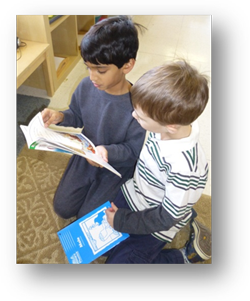
First off, I would like to thank all the children who participated in the Read to Feed program for Heifer International. The children did a wonderful job keeping track of books they had read. Students raised enough money to purchase one goat, one group of rabbits, one group of tree seedlings and one group of geese. What wonderful gifts to be able to give families around the world in need.

The Elementary and Kindergarten classes also attended the Challenger Learning Center at the beginning of the month. Unfortunately, due to illness, I had to miss this trip. From what I heard, it was a great trip and those who attended last year learned even more this year.
We also had scheduled a trip to the McHenry County Animal Control, but it was cancelled due to a few students being absent. This trip will be rescheduled for April. As a reminder, please have your child collect any old towels, newspaper or blankets that can be donated to the cats and dogs at the Animal Control Center.
We also had to postpone another field trip due to weather. We had scheduled to hike over to Veterans Acres Park to look for signs of Spring. However, with snow still on the ground and the cold weather, we will wait and take this trip when we return from Spring Break. Hopefully we will be able to see some tree buds by this time!
Our classroom has been busy this month as well. We added a Yoga work that will be completed when the children come back to school. The children decided they would like to make their own yoga position cards. To do this, each child chose three yoga poses and I took a picture of each one. When the children return in April, the cards and Yoga mat will be available for use during class time when a student feels like doing some movement and stretching.
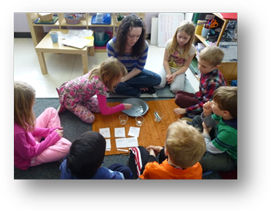
Another work that the children really enjoyed this month is our question boxes. There are four boxes labeled “who”, “what”, “where” and “when”. Each box contains different ideas. For example a student might take out the following: my pet, a football, my house and in the morning. Using these four prompts they are able to create a story. There are many different combinations and some can make perfect sense, and others can be rather creative and a bit humorous.

In Math, a highlight this month was an introduction to Golden Bead Division. The students have now been introduced to all four mathematical operations using the Golden Bead Work. The challenge now becomes remembering the process for each one. Each mathematical operation has an introductory story that helps the children remember a key concept. The story for division included three greedy goblins and the goblins were so greedy, they always wanted to start dividing up the thousand cubes first!

In Language, the children were introduced to the Grammar Farm. The students have been working with nouns, articles, adjectives and verbs. With the farm, the children pick out animals and prepared labels for each part of speech to create sentences to illustrate what is happening at the farm. The children really took to this work and some created many, many sentences. In April, I will send home a picture of each child with the farm they created.
In our Cultural area, this month we were busy continuing learning about the water cycle and how it connects with different water features such as oceans, seas, lakes and ponds. We also continued using our timeline of people and focused on how food and clothing have changed over time.
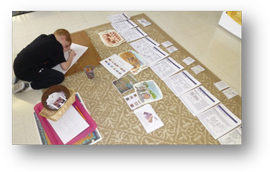
In our invertebrate study the children were introduced to the platyhelminth and nematodes.
To conclude the month and in Celebration of Spring we made egg shell grass people. These little people can be planted in the ground (once it thaws) and the egg shell will help feed the grass and decompose.
This month, I have observed the children becoming much more confident in their work and taking a greater leadership role in the classroom. This role will serve as a great benefit to both this group of children along with the new first grade students we will have next year. We also had a visitor this month. She relayed to me that the children are working as a team and really know how to problem solve with one another. She noticed how the children knew the materials and were using a wide variety of them. This first group of Elementary students at Pathways has really developed into mature 6 and 7 year olds. I am so happy I have been able to see them grow so much this year!
Miss Katy
Notes from the South Classroom
Ms. Jocelyn and Ms. Ambreen
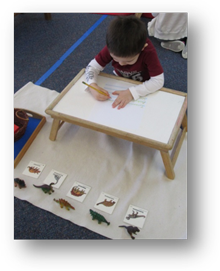
In the South Room we are starting to think that the groundhog was mistaken about the spring this year! March has been blustery cold with lots of practice of zipping coats, putting on and hanging up snow pants and taking off and putting on boots, hats and mittens. All this daily practice has really created a whole lot of independent children along the way! While we love to see this blossoming independence we are all ready for some warmer weather and the blossoming of flowers outdoors.

This month in the South Room, the children had the opportunity to try several new kinds of works. In Science, we had many new dinosaur works such as dinosaur matching cards, dinosaur vocabulary cards, dinosaur stencils, dinosaur bingo and dinosaur dominoes. Some children worked on coloring and labeling the parts of the Stegosaurus, while others used small dinosaur figurines to learn the names of the different kinds of dinosaurs. We were also very lucky that Ms. Patty generously loaned us some of her really cool dinosaur books. One book showed the life-size pictures of different dinosaur body parts. Thank you Ms. Patty! Also in science new works about the layers of the Earth and land and water forms were explored by many of the children.

In the Language area, new works included word riddles, a silent “e” reading basket, parts of speech cards and Spanish vocabulary cards. As so many of the children in the South Room are interested in learning their sounds and reading , we will be adding new language works frequently in order to keep each child challenged and moving along as they are ready.
In the Math area, numeral dice addition was introduced this month. Rather than the child counting out the dots on 2 rolled dice to complete their addition equations, with numeral dice addition the child reads the numeral then finds the corresponding bead bar and then counts the beads to complete the equation. This form of dice addition is a small step towards abstraction and allows for a strong foundation for later math works.
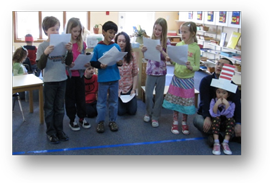
In March, our author of the month was Bill Martin Jr. Bill Martin Jr. is most known for his books titled “Brown Bear, Brown Bear what do you see” and “Chicka Chicka Boom Boom”, but he is actually the author ( and illustrator) to over 300 children’s books! One of the books the children really loved was “The Happy Hippopotami”. This is a silly rhyming story where the characters are hippopotamamas (mamas), hippopotapapas (papas), hippopatasons (sons) and hippopatadaughters. Listening to the rhyming couplets on each page and looking at the silly activities the hippos were doing made for a really fun read aloud. Thank you to Sydney and her Mom for going to the library and choosing 10 Bill Martin Jr. books for us to read together at line time.

Finally, this month we celebrated another great author, Dr. Seuss for our South Room March morning. For this special day, five stations were set up for the children to explore. The activities included creating green eggs (“Green Eggs and Ham”) by dyeing hardboiled eggs green, making red and white striped hats (“The Cat in the Hat”) and making silly clay creatures (really every Dr. Seuss book).
We also had a Dr. Seuss book corner and a healthy snack station of cucumbers and kiwis. Thank you to Ms. Sally (Shawn and Alia’s Mom), Mr. Hao (Elizabeth’s Dad), Ms. Susan (Audrey’s Mom) and Ms. Tammy (Sydney’s Mom) for coming in to help with the activities on our Dr. Seuss morning- we couldn’t have done it without you!
Warmly,
Miss Jocelyn and Miss Ambreen
Kindergarten Extended Day News
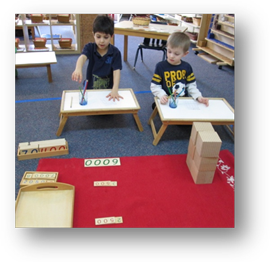
Spring of the Kindergarten year is the time when many “aha moments” happen for the children. All of the practice with individual works suddenly makes sense and connections are formed that transform their knowledge from completing a work to truly understanding a work and how it relates to other works they are practicing.
In Math, this month the Kindergartners worked on an extension project using the Bead Cabinet to work with and record the Square Chains for 1-10. After weeks of practice, each child used the foundational skills of skip counting to create a comprehensive numerical listing of the “Squares” of each number.

As they worked on this project many of the children made the connection between the short chain values and their answers when completing the multiplication board equations. One child cried out, “hey, the numbers for the short chain 5 are the same numbers I get when I do the multiplication by 5’s equations”. This instantly led the other child to explore and discover that this was indeed true for all of the chains.
The Square Chains project also added the visual element of equating the numbers with the physical manipulation of the chains in order to form a square (and that’s why we call it the square of a number!) The Kindergartners all took turns transforming the short chains into the square and were amazed every time that no matter how long the chain was it would create a square. Next time you are visiting the classroom, be sure to ask one of the Kindergartners to show you how this works!

Other works in Math the Kindergartners explored in March include completing division equations using the division board, addition bingo, numeral dice addition, the multiplication board, and extensions of the Bankers Game to explore 2, 3 and 4 digit addition equations.
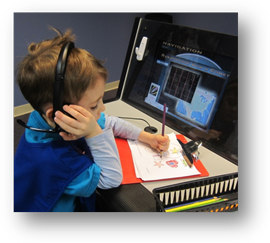
The beginning of March saw the completion of our study of the solar system with a culminating field trip to the Challenger Learning Center in Woodstock. The children had several missions to complete while on this field trip. Some missions required using headsets to work with a partner in another room to complete a task; others utilized joy sticks and robotic arms to manipulate work activities similar to those that astronauts complete at the International Space Station. There was also a pet goldfish to observe and a medical station to weigh, measure and record hand strength.
Thank you so much to Mr. Joe (Mark’s Dad) and Ms. Song (Elizabeth’s Mom) for driving and assisting the children while they completed their space activities.

In Science the rest of March was all about dinosaurs in Kindergarten. The children participated in group research to learn about the Apatosaurus, Stegosaurus, Triceratops, Tyrannosaurus Rex, Velociraptor and Pterodactyl. Each day the children would research and learn new facts and then review the facts learned on the previous day. Many different dinosaur activities were available to try and complete on their work plans. The Kindergartners took an active role in being mentors to the younger children and sharing their new knowledge about dinosaurs as they worked together. The Kindergartners completed a fun dinosaur skeleton project with Ms. Patty and created their own dinosaur poem book and made their own fossils to finish up our study of dinosaurs.

The Kindergarten and Elementary children together participated in a service learning program in March called Read to Feed. Heifer International’s Read to Feed program empowers children to be active participants in helping other people all around the world. The children raised money through donations based upon the number of books they read so they could give the gift of livestock to a needy family.
Our initial goal was to raise enough money to give the gift of a goat. I am proud to report that the Elementary and Kindergarten children, working as a team far surpassed this goal and raised $289! Since we more than doubled our goal the children had to work together to decide how we would gift the money. It was decided that we would come up with three different choices and then each child would cast a vote.
First we created the three choices based upon the money raised:
1. One water buffalo
2. One goat, one pig and one hive of honeybees
3. One goat, a trio of rabbits, tree seedlings and one flock of geese
Then each child privately cast his/her vote by writing the number of their choice and putting it into the ballot box. After every child had a turn to vote we met as a group to open the ballot box and the children were excited to see that choice number 3 was our winner! Ms. Katy and the Elementary children completed our donation form and mailed our off the children’s hard earned donation money. Thank you to all of the Elementary and Kindergarten families for supporting this very meaningful service learning project.
Miss Jocelyn
Notes from the East classroom
Ms. Paty and Ms. Christine

Happy Spring to you all! Even though it still feels like winter, we have introduced some new spring like works into our classroom. In the Practical Life area, we are seeing colorful pastel eggs, bright yellow and neon objects for spooning, transferring and pouring activities. The children love to rediscover these work choices when we simply change their contents each month/season!
Beautiful artwork has been created using 3 or 4 hearts joined at the point to make cloverleaves for St. Patrick's Day which we celebrated on the 15th.

Thank you to Aidan's dad, Andy, for helping the class make cloverleaf rolls with homemade butter - delicious! Thanks to Isabella's mom, Julia, for helping with the cloud/rainbow craft, and thank you to Treyson's dad, Chris, for helping the children cut up kiwi and honeydew melon for a special green snack.
We then enjoyed acting out a short poem about 5 little shamrocks (everyone had a turn to be one!) and one skipping leprechaun who put them in funny places such as a tree, a door and even a shoe! It was amusing to watch the children participate and they enjoyed acting out the words.
We (well........most of the class) enjoyed tasting green peppers with and without Ranch dressing. The verdict was that green peppers taste better with Ranch (doesn't everything?). After noticing how many seeds there were in the middle, we removed them and made "shamrock" prints by dipping the peppers into green paint and stamping them onto paper.
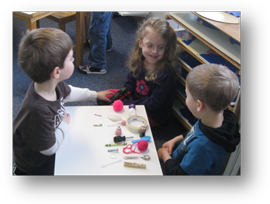
In the Sensorial area of our class, we introduced sorting small teddy bears by color, then labeling and coloring them properly to create a book. We have added some new multi-layered puzzles which are challenging and fun, as well. To keep the Mystery Bag's mysteriousness, the items have been changed so the children have renewed interest in guessing what they are feeling when they reach in. This is a fun activity and the children are also getting lots of new vocabulary words, too. We also are practicing the names of our geometric shapes as well as working on matching them to the drawers in the Geometric cabinet. Some colorful replications have been created and hopefully you've seen and admired their work sent home.
We continue to practice math skills at each child's appropriate level, daily. We have introduced a new fraction work, which involves fruits and dividing each fruit into 1/3's, 1/4's, etc. It is a challenging concept but easily explained when it is a food item to "cut" and then share with 3 or 4 friends.
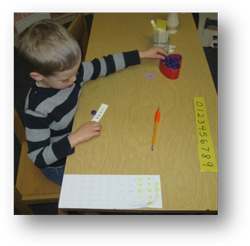
Ongoing introduction and extensions are happening with the 100 Board and the 45 Layout. Quite a few children are working with Circle Addition Equations, where a stationary number is in the middle of a circle and subsequent numbers on the perimeter are added to it. It requires knowledge of addition, correct association of counters to quantity, and the ability to stay organized for correct placement of the answer.

Language is a busy area in the classroom every day. Some children are working on new, phonetic letter sounds, some are working on word building 2-letter blends such as "at" or "in" words. There is a lot of work with sequencing- what comes first, next, etc., and Cause and Effect materials. We also practice letter and numeral writing and several children no longer need assistance from the yellow highlighter to write words or numbers! A few children are able when verbally given a sentence from a book, to then reconstruct it from memory using the movable alphabet - it is quite challenging to remember the sentence and then build each word individually to complete the sentence correctly.
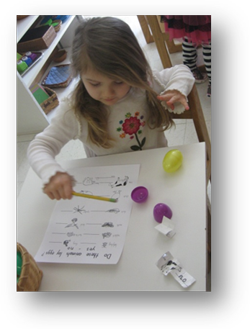
In Science, we have a new work that explores which animals lay eggs versus giving birth to a baby. This work entails opening a plastic egg with a piece of paper that has the name of an animal, and then the child has to guess whether it lays eggs or gives birth. There is a corresponding worksheet that is then filled out with the correct answer. Some children have chosen to work on Parts of the Earth, Animal Classification- matching animals to labels, and because we are celebrating a new season, the Seasons work is a popular choice now. In addition, the Life Cycle of a Rabbit and Parts of a Rabbit are new choices in this section of the classroom.
Lots of activity is happening in Geography especially the making of maps! Europe, North America, South America, Australia, have all been laid out and completed this month. And of course, the Continent Map is always a work in process! We have observed thoughtful work with land, air and water with some choosing to create their own personal books using pictures from magazines.

We wished our friend Emily a Happy 4th Birthday on Friday. Thank you to her grandma, Marion for making the most delicious brownies which were enjoyed by all. We also liked her pictures for Emily's Celebration of Life. She was happy making a poster with them and seemed to relish her friends singing Happy Birthday!
Thank you for your time during conferences. It is always nice to see our parents and share information about your child. Please feel free to contact us whenever you have questions or need anything at all.
Wishing you all a warm and relaxing Spring Break wherever you are. If you are indeed going someplace warm, please bring back some warmer weather for us still here in Crystal Lake! Enjoy!
Sincerely,
Ms. Paty and Ms. Christine
Notes from the afternoon classroom
Ms. Terri
 Elementary Art News:
Elementary Art News:
Our species this month is Birds. We chose an owl for this art project. After looking at many varieties of owl we noticed that they all have the color brown in them. So the next week we learned to make the color brown by mixing the three primary colors. It sounds easy but it can be both a fun and frustrating experience. To mix the color brown you use lots of yellow (weak pigment), a little red (stronger pigment) and the tiniest bit of blue (strongest primary). We found out if our color is too purple we add a little yellow, too green we added more red or if we needed a lighter brown we added a little white – you get the idea.
The next week we took the information we had acquired and started our painting. The children drew the owl using basic shapes of circles and ovals. Then, after they had mixed their tempera paints on their palettes, they painted their owls. The challenge after mixing theirs paints was the texture of the owl and figuring out how to use their paint brushes to paint feathers. It was lots of fun and we all decided we need more time for art because it’s hard to stop and time goes by so quickly!
 Kindergarten Art News:
Kindergarten Art News:
The kindergarten class looked at the artist Michelangelo this month. The art technique Michelangelo used was called “fresco” or painting on plaster walls and ceilings.
When the plaster is damp the paint is absorbed into the plaster and gives a longer lasting finish to the work.

When creating our own frescos, we used round aluminums cake pans as a mold. After mixing Plaster of Paris with cold water we poured the mixture into the mold and waited for the plaster to set. We removed the hardened damp plaster from the mold. Next, we painted a picture of our choice onto the damp plaster with watercolors. The plaster was warm to the touch as it dried and also very smooth on the molded side. We also noticed that the damp plaster has a very absorbent surface and our watercolors did not flow as they do on paper. It was a very fun project as well as a delightful sensorial experience!
Pre-Kindergarten Art News:
The pre-kindergarten class’ favorite project this month was based on the story “Three Bill Goats Gruff.” The story involved a rickety wooden bridge over a stream that has green grass filled with clover on one side and brown, grassless dirt on the other, 3 Billy goat brothers and a troll who lives under the bridge whose favorite food just happens to be goat!
We used colored pencil, crayon, and watercolor and cut paper strips to make our bridge. Then, our special addition was a troll made out of clay – complete with red eyes, fangs, claws and a green body and head. It was a lot of work to soften the clay and mold the shapes but boy did they have fun making their version of the ugly, hungry troll. Since many of the children choose this story at reading time it was extra special to do a project related to it!
Our baking recipe this month was Apple Cinnamon Muffins (which we poured into a 9”x13” pan to make more servings).
Here’s the recipe – enjoy!
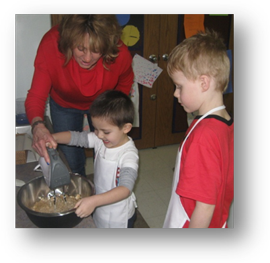
Apple Cinnamon Muffins
2 c. flour
1 t. baking soda
1 t. cinnamon
½ t. salt
2 large eggs
½ c. agave sweetener
½ c. sunflower oil
½ c. milk or dairy alternative
1 t. vanilla
1 c. applesauce

- Preheat oven to 350°
- Grease pan or line muffin cups
- In medium bowl combine flour, baking soda, cinnamon and salt
- In a separate bowl, whisk eggs, agave, oil, milk and vanilla and stir into flour mixture to combine
- Stir in applesauce
- Scoop into pan or muffin cups
- Bake for 18-20 minutes
**Variation: add one cup frozen blueberries for blueberry muffins!
Warmly,
Ms. Terri
